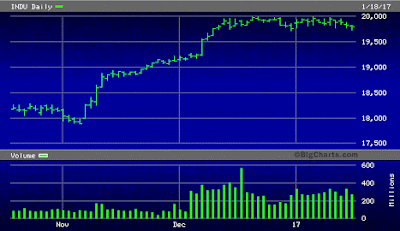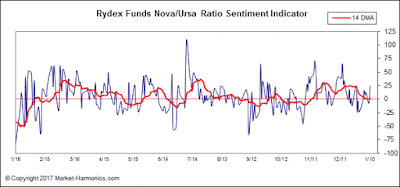After touching the benchmark 20,000 level last month, the Dow
Jones Industrial Average has spent the last five weeks in a tight, narrow
trading range just under this level.
Famed trader Jesse Livermore theorized in his pseudonymous book, Reminiscences of a Stock Operator, that
stocks are attracted to major round number levels. In the case of the Dow, the 20,000 level has
generated more press and speculation among investors than any number since the
formerly mythical 10,000 level was crossed in 1999. Clearly Dow 20,000 carries a tremendous
psychological significance, even if it’s a simple case of self-fulfilling
prophecy.
While
the technical significance of Dow 20,000 can be endlessly debated, the action
of the Industrials in the weeks following the first test of this level is of
more immediate concern. To wit, does the
action of the last several weeks represent a normal consolidation (i.e. a
“pause that refreshes”), or is it indicative of distribution (i.e. informed
selling)? The NYSE tape doesn’t suggest
distribution since the new 52-week high-low differential has been mostly
healthy in the last few weeks while market breadth has also been confirming,
and in some cases leading, the advance.
It’s
possible, however, that the extended effort to push above Dow 20,000 could be
the prelude to a distribution phase. In
an earlier commentary we discussed the distinct possibility – based on the
“echo” of the 10-year cycle – that the coming months could witness a blow-off
interim top, followed by significant decline at some point later in the
year. Historically such declines have
occurred in the late summer/early fall months, particularly in the seventh year
of the decennial rhythm.
A
run-up above the Dow 20,000 level, should it occur, would undoubtedly generate
lots of enthusiasm among the hold-outs in the retail investor camp. There’s still a huge amount of money on the
sidelines right now with small investors still skittish about buying stocks at
current valuations. But greed is a
persuasive argument, and if the Dow breaks out decisively above 20,000 in the
coming weeks it would serve as a magnet for sidelined money. One thing that investors can’t stand more
than anything else is watching an historic rally while they’re sitting in cash
and not participating. A breakout above
20,000 would likely trigger the primal instincts of these
non-participants.
Although
the 20,000 level carries great psychological significance its technical
significance hasn’t yet been cemented.
In order for 20,000 to become technically significant it must be
established as a “seldom crossed line.”
A seldom crossed line is a concept developed by the late market
technician P.Q. Wall. Wall emphasized that
when an individual stock or market index crossed an important price level only
a few times in its history, the level takes on added significance as both a
support and resistance level. He wrote:
“If
cycles exist at all there must by that very fact be equidistant lines of price
on a vertical scale that rise as more energy enters the market. These should be seldom crossed lines between
which price tends to cluster about equilibrium points that mathematicians would
call strange attractors but that we call magnetic midpoints….Electrons in an atom
rise and fall in just such stair steps.”
Take
for example the chart of the Dow Industrials shown below. While many investors touted Dow 10,000 as a
critical level back in the late ‘90s and early 2000s, that particular level was
actually crossed many times on both the upside and the downside. By Wall’s reckoning, this invalidated the
10,000 level as having major significance as a long-term support or resistance
level – as history subsequently proved.
Wall
believed that when a stock’s price encountered resistance at a key level
without breaking above it then finally succeeded in breaking out the rally that
followed would be noteworthy. For the
Dow, the closest thing to a seldom crossed line is the 14,000 level. This was established as a pivotal level when
the Dow broke out above it in 2013, then proceeded to rocket all the way to the
18,000 level before wavering. In the
future, any major decline that tests 14,000 is likely to be turned back due to
the established technical significance of this level.
As
for Dow 20,000 you can see in the following snapshot of the last three months’
worth of trading action that the level in question hasn’t been penetrated on
the upside yet. This is an important
first step toward the establishment of a seldom crossed line. The Dow has yet to lay claim to this
important designation of the 20,000 level, however. The key ingredient here is time and the
reaction of the Dow’s price line to this pivotal level in the coming days.






